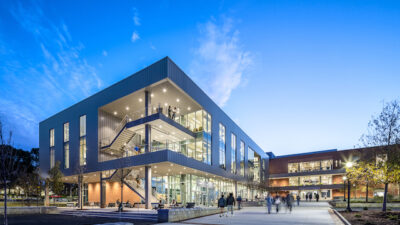Engineering Expo Day at the University of Kansas (KU) is really, really loud. The hallways of the school's engineering building seem to be specifically designed to amplify the voices of the hundreds of junior high and high school students who roam like packs of Vandals just dying to sack Rome. Engineering classes are cancelled.
Engineering Expo Day at the University of Kansas (KU) is really, really loud. The hallways of the school’s engineering building seem to be specifically designed to amplify the voices of the hundreds of junior high and high school students who roam like packs of Vandals just dying to sack Rome. Engineering classes are cancelled. Instead, college students serve as carnival barkers, luring the younger kids into candy-colored classrooms full of things that pop, flash, sizzle, gush and beep. All the better to convince them that engineering isn’t boring.
It’s a worthy goal. Over the past 50 years, the field of engineering has become broader and more important, creating jobs that need to be filled. But filling those positions can become a problem when older engineers and younger engineers aren’t communicating. In order to recruit the best college graduates, firms need to understand why young people are going into engineering, what aspects of engineering are important to them and what they want in a job. This is especially true for HVAC and building systems, which don’t have the hip cachet that disciplines such as automotive design and computer engineering bank on.
The KU Engineering Expo, and the nationwide programs that are its cousins, are an important first step in recruiting because of the way science and math are approached in secondary school. “A lot of younger kids have a fear of math and science. I think the teachers see it as work, and they treat it like work,” says Aaron Weigel, a KU senior in mechanical engineering, who got his engineering start in the Science Olympiad of his public school’s gifted program.
This is not surprising, says Robert Sorem, associate dean of undergraduate studies in engineering at KU, as most young engineers share a similar epiphany. But he cautions that such engineering inclinations must be further cultivated. “I don’t think there are a bunch of little kids running around going, ‘I love HVAC systems,'” he says.
Renee Azerbegi certainly didn’t. Azerbegi graduated from the University of Colorado-Boulder (CU) three years ago and now works for Lakewood, Colo.-based RMH Group. Originally a computer science major at the University of California-Berkeley, Azerbegi toyed with environmental studies before finally settling on studying building systems at CU. Quality of education, frankly, was a big factor. “Computer engineering was highly competitive and had huge classes. The teachers didn’t speak English well. It was hard to learn,” she says.
Luis Summers, a CU architectural engineering professor, knows what a difference a professor can make. He says it takes a strong teacher to turn students on to HVAC and building systems. Far too often, the people teaching those classes don’t have practical experience in the field.
This is especially important because the real world is a major reason students choose a career in building systems engineering. For example, Matt Malinosky enrolled at the University of Minnesota intending to get a degree in mechanical engineering and go on to design cars. Now, three months from graduation, his focus has changed to HVAC. What happened? “I found out that to be an automobile designer, I’d have to move to Detroit. I didn’t have any interest in that,” he says. Through a friend’s father he found an internship at an M/E consulting firm in the Minneapolis/St. Paul area. He started doing HVAC work there and tailored his remaining classes toward that field.
KU’s Sorem says that location and job availability unquestioningly influences the decisions of many students. “Kansas City has perhaps the highest percentage of consulting engineers of anywhere in the world, so our students get a lot of exposure to that,” says Sorem. “If they want to stay in the area after they graduate, that’s what they migrate toward.”
Location was a big influence on Malinosky’s career plans, but he’d have never even thought about HVAC if not for his internship. That experience gave him the chance to learn what consulting was about and how it was done. Internships are an opportunity for firms to capture the attention of qualified graduates who might otherwise not enter those fields. And you don’t have to wait for them to come to you. Many universities across the nation have cooperative programs that allow firms to get proactive about recruitment.
One of the oldest cooperative programs in the Midwest is at the University of Minnesota. Although Malinosky didn’t find his internship through the program, Thomas Kuehn, professor of mechanical engineering at Minnesota, says the cooperative system is useful. Each year, local firms come to his university and interview students for internship positions. Faculty match students’ top choices to the firms’ top picks, and for two years the students alternate semesters between school and work. Ideally, Kuehn says, students get experience in several different building systems so that when they graduate, they have a better idea of what they’d like to do.
Proactive outside involvement is also playing a huge role in student recruitment at the University of Missouri-Rolla. There, the Granger Foundation funds a program that awards $5,000 to students who complete an option in power systems with a B average or higher. “The first year, I don’t think the students truly believed it,” says E.K. Stanek, professor of electrical engineering. “All of a sudden, the realization set in, and our classrooms really filled. Companies and foundations can have a huge influence on what courses students take. We now have a high percentage who go on to work for power systems and as facilities engineers.”
Interaction between firms and students provides benefits beyond simple technical experience; it’s also an opportunity to bridge the generation gap between seasoned and young engineers. It isn’t news that old timers and young pups have trouble getting along; it’s often a case of dissatisfaction with the basic technical knowledge that young hires exhibit. But understanding the issues that hold them apart is the first step toward bringing them together.
One of the biggest problems, says KU’s Sorem, is the difference in the way older and younger engineers have been trained. Forget “gap” here; think Grand Canyon. Thirty years ago, the paradigm for engineering education included formal respect for superiors, memorization and a reliance on libraries and math done by hand. Today’s students learn in a much more casual, hands-on environment. They use top-of-the-line calculators, and when they have to do research, they just “Google” it. “I have older professors who like to do graphical solutions rather than mathematical ones,” says Weigel. “But I have a calculator that can do up to calc 3, and I just want to plug it in and go.” He says some older engineers interpret this reliance on technology almost as cheating. But Weigel insists he isn’t lazy; he was just trained to solve problems differently.
UM-Rolla’s Stanek agrees that veteran engineers have a different approach to problem solving. “Hopefully, they’ve all gotten rid of their slide rules,” he says. But he adds students need to under-stand the advantages of the old ways as much as some experienced engineers need to understand the new ones. Students tend to take computer output as gospel, he says. They don’t have the intuition older engineers developed long ago. “They think computer results are more accurate,” says CU’s Summers. “But older engineers can look at the number and know it doesn’t make sense.”
Another thing that’s changed since the era of slide rules is what recent graduates expect in a first job. When Professor Stanek graduated from college, young engineers spent their first couple of years on the design board, paying their dues through detail work and redlining. But today, one engineer can do in a day what once took 15 people a week to accomplish. As a result, today’s grads don’t expect to be relegated to number crunching or designing only one part of a system over and over. “I just want to have the chance to learn how to design all the systems and, hopefully, be given the opportunity to integrate them all with some type of a control network,” says Jake Wayne, an architectural engineering graduate student at KU. Systems integration and customization are important to Minnesota’s Malinosky, as well. He’s primarily interested in the commissioning of mechanical systems.
Students say some firms don’t realize new engineers would be more useful if they started out working on projects like those that teach new skills and pique their interest rather than what they see as doing repetitive, boring design work.
To make a scenario like this possible, students say they need a work environment geared toward education. “People say we don’t know what we’re doing when we first start out, and they’re right,” says Azerbegi.
Engineering education is broad, but not deep. Young engineers leave college without knowing the fine details of specific fields and are acclimated to a school setting where they have constant guidance and direction. Obviously, a professional engineer can’t rely on supervisors to tell them what to do every step of the way, but young engineers say a little structure and direction creates better engineers in the long run. One way to do this, Azerbegi says, is with catalogued design standards. “If you ask three different engineers how to do something, you’ll hear three different answers,” she says. At RMH, she works with a series of standards that help her navigate her new career but leave enough room for flexibility and personal touch.
She also praised RMH’s mentor program and a series of technical reviews where her design is checked at different stages by experienced engineers who offer constructive criticism and instruction. “Every time you go through a review, you learn a lot, and it ensures the project is high quality,” she says.
Bridging the gap
Ultimately, being able to communicate with and learn from experienced engineers is of utmost concern to recent grads. They’re looking for mentors and an environment where they can continue to learn, where engineering is still as big an adventure as it was when they were school kids at an exhibition. KU’s Wayne says that’s what he’s liked most about the internships he’s had. “I want them to appreciate that I’m still learning. I’m a student; I don’t have their experience,” he says. “But if I’m given the opportunity to ask the questions and learn how to do it… if we can just work together, it’s a great experience.”



